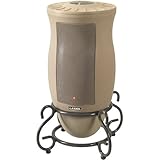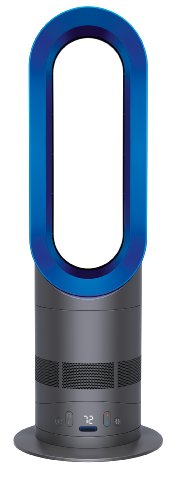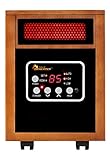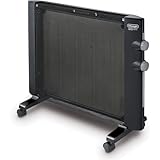Finding an Energy-Saving Space Heater in 2015: Keep Warm on a Budget
Winter is on approach, and it's getting colder. I live in a part of the world where heaters are a necessity, and it can get pretty expensive burning natural gas all winter. Sometimes central air heating isn't practical. A small, energy-efficient space heater can be the perfect thing.
That said, not all space heaters are the same. Some make use of ceramics and others make use of other technology. They're all different shapes and sizes, and some of them are a huge drain on your electrical bill each month. Some are even fire hazards!
Because it can be tough to narrow down a heater that combines good energy efficiency, low price, safe operation and small size, I'm writing an article to showcase a few good ones. We'll look at six (plus a bonus one) of the best energy saving space heaters and give a run-down of their specs and how well they operate. I'll also briefly touch on a couple of the popular technologies these days, so you'll understand what you're looking at! Let's begin.
That said, not all space heaters are the same. Some make use of ceramics and others make use of other technology. They're all different shapes and sizes, and some of them are a huge drain on your electrical bill each month. Some are even fire hazards!
Because it can be tough to narrow down a heater that combines good energy efficiency, low price, safe operation and small size, I'm writing an article to showcase a few good ones. We'll look at six (plus a bonus one) of the best energy saving space heaters and give a run-down of their specs and how well they operate. I'll also briefly touch on a couple of the popular technologies these days, so you'll understand what you're looking at! Let's begin.
Different Types of Space Heaters
There are many different types of energy efficient space heaters, and they're all subtly different. Here's a brief description of a few of the popular styles:
Convection Style
These are built to gradually increase the air temperature of the whole room, by directing warm air upwards. They work slowly, but they can fill a whole room with warmth. Some examples of this include baseboard heaters and oil and water radiators1 (despite the name, a radiator heater uses convection, not radiant heat).
Radiant Style
Radiant style heaters2 work more quickly, but they direct their temperature in a single direction. They're useful for heating up a single person or single area of a room. Most ceramic and infrared style heaters are radiant style. They're quicker, but typically use a bit more electricity.
There are also some hybrid style space heaters that are very energy efficient. They make use of a combination of the two styles I just covered.
Convection Style
These are built to gradually increase the air temperature of the whole room, by directing warm air upwards. They work slowly, but they can fill a whole room with warmth. Some examples of this include baseboard heaters and oil and water radiators1 (despite the name, a radiator heater uses convection, not radiant heat).
Radiant Style
Radiant style heaters2 work more quickly, but they direct their temperature in a single direction. They're useful for heating up a single person or single area of a room. Most ceramic and infrared style heaters are radiant style. They're quicker, but typically use a bit more electricity.
There are also some hybrid style space heaters that are very energy efficient. They make use of a combination of the two styles I just covered.
Lasko Designer Oscillating, Energy-Saving Space Heater
If you're after a relatively inexpensive space heater that's energy efficient and looks great, this product by Lasko might be right up your alley. It has a wide range of features and it's really user-friendly.
With up to 1500 watts of heat, this is a powerful heater in a small package. It oscillates widely on its base and has a bunch of different temperature presets on the top, as well as various fan outputs that let you control how much heat is produced and how widely it's distributed in the room. That makes it wonderful for just a single person, but it's also useful for a larger space too.
It even has a timer with settings for as long as seven hours of use.
The housing is unique among space heaters in that it looks sort of like an urn or decorative vase, definitely nothing like the sterile gray that space heaters usually come in.
The heater unit is ceramic, so this should be considered a radiant heater. With that said, it's actually pretty good at warming up a pretty big room in short order. Because it relies on ceramic elements, it warms very quickly, but it won't maintain that warmth as long. It's good for heating up a well-insulated space quickly, but it becomes less efficient if it has to run constantly.
It is sturdy, very quiet, attractive, and doesn't tip over easily. Beyond that, it's a pretty efficient electric space heater that will last.
With up to 1500 watts of heat, this is a powerful heater in a small package. It oscillates widely on its base and has a bunch of different temperature presets on the top, as well as various fan outputs that let you control how much heat is produced and how widely it's distributed in the room. That makes it wonderful for just a single person, but it's also useful for a larger space too.
It even has a timer with settings for as long as seven hours of use.
The housing is unique among space heaters in that it looks sort of like an urn or decorative vase, definitely nothing like the sterile gray that space heaters usually come in.
The heater unit is ceramic, so this should be considered a radiant heater. With that said, it's actually pretty good at warming up a pretty big room in short order. Because it relies on ceramic elements, it warms very quickly, but it won't maintain that warmth as long. It's good for heating up a well-insulated space quickly, but it becomes less efficient if it has to run constantly.
It is sturdy, very quiet, attractive, and doesn't tip over easily. Beyond that, it's a pretty efficient electric space heater that will last.
Dyson Hot + Cool: A Versatile and Powerful Heater / Fan Combination
You may have seen the advertisements lately extolling the virtues of the new Dyson vacuum and fan products. I've checked them out and I have to say they're living up to the hype.
They may be on the expensive side, but all Dyson products are very intelligently designed and built to be not only powerful but beautiful too.
This particular space heater and fan is efficient, energy saving, and versatile. You can use it as a heater in the cold months, and then switch it to a fan to blow cool air during the summer. No more storing it in the basement for half the year!
Their "air multiplier" technology means that the air is drawn in from around the device rather than pushed through. That results in a "buffet-less" airflow that's far more relaxing than a conventional fan.
That same air multiplier means that heat is pushed efficiently through the room, so you don't have to sit directly in front of it to gain the benefits, and it's good for heating up a decent-sized space.
It tilts and oscillates, and it's capable of projecting a huge volume of air, so it can really warm up a big space quickly. Surprisingly enough, it doesn't draw a huge amount of juice either, so your electricity bill isn't going to expand too much. It even avoids that typical space heater "burning smell" generated by dust on the elements!
Overall this is a pricey but full-featured and powerful space heater that offers energy savings to boot!
They may be on the expensive side, but all Dyson products are very intelligently designed and built to be not only powerful but beautiful too.
This particular space heater and fan is efficient, energy saving, and versatile. You can use it as a heater in the cold months, and then switch it to a fan to blow cool air during the summer. No more storing it in the basement for half the year!
Their "air multiplier" technology means that the air is drawn in from around the device rather than pushed through. That results in a "buffet-less" airflow that's far more relaxing than a conventional fan.
That same air multiplier means that heat is pushed efficiently through the room, so you don't have to sit directly in front of it to gain the benefits, and it's good for heating up a decent-sized space.
It tilts and oscillates, and it's capable of projecting a huge volume of air, so it can really warm up a big space quickly. Surprisingly enough, it doesn't draw a huge amount of juice either, so your electricity bill isn't going to expand too much. It even avoids that typical space heater "burning smell" generated by dust on the elements!
Overall this is a pricey but full-featured and powerful space heater that offers energy savings to boot!
DeLonghi Safeheat Oil Radiator: Inexpensive and Powerful
I usually recommend an oil radiator for anyone who needs consistent heat in a small space, because they're among the most energy efficient space heaters on the market today. This example by DeLonghi shows you just how much you can get for well under $100.
The advantage of oil radiators is that the oil inside retains heat really well. Once it's heated up, you can actually turn it off or lower the heat, and it will continue to provide convection warmth throughout the space for a long time afterward.
This particular radiator has fins that never need to be refilled or topped up with oil. The unit can be set to automatically turn on when the room drops below 44 degrees Fahrenheit, and it will also automatically shut off when the heat gets too high.
It's also virtually silent; the only thing you'll hear is the occasional "ticking" of metal expanding and contracting. I had one of these operating in my bedroom for years, and they're wonderful!
They do take a bit of time to warm up, and likewise if it gets too hot they take some time to cool as well, but it's an extremely safe and very energy-efficient space heat option that won't break the bank.
The advantage of oil radiators is that the oil inside retains heat really well. Once it's heated up, you can actually turn it off or lower the heat, and it will continue to provide convection warmth throughout the space for a long time afterward.
This particular radiator has fins that never need to be refilled or topped up with oil. The unit can be set to automatically turn on when the room drops below 44 degrees Fahrenheit, and it will also automatically shut off when the heat gets too high.
It's also virtually silent; the only thing you'll hear is the occasional "ticking" of metal expanding and contracting. I had one of these operating in my bedroom for years, and they're wonderful!
They do take a bit of time to warm up, and likewise if it gets too hot they take some time to cool as well, but it's an extremely safe and very energy-efficient space heat option that won't break the bank.
Dr Infrared Quartz Space Heater: Attractive and Potent
You might have seen infrared heaters like this one advertised on late night television. They're pretty popular and gaining fans every day. They're a bit larger in size than your conventional space heater, but they provide a huge amount of heat without drawing a ton of power.
They're big, but not huge, at around 13 x 11 x 16 inches in dimension. They're definitely what I'd consider portable, because you can tote them around easily enough.
The technology incorporates typical element heating with infrared heat, which is where the 'quartz' in the name comes from (infrared heaters typically use a quartz tube of some kind). That means that it heats up extremely quickly and will start projecting almost the moment you switch it on.
These heaters make claims of heating up to 1000 square feet. In my experience, that's not realistic. However, they're pretty good at heating up spaces of up to 500 square feet quickly, and they have the capability to fill the room with warmth rather than just blasting it in a single direction.
Feature-wise, it has a 12-hour timer, a fairly quiet fan, front panel push-button controls that are simple to use, and a very precise thermostat to regulate the temperature. It has a three-year warranty too.
It's a very energy-efficient infrared space heater that happens to look great too! Worth taking a look at for sure.
They're big, but not huge, at around 13 x 11 x 16 inches in dimension. They're definitely what I'd consider portable, because you can tote them around easily enough.
The technology incorporates typical element heating with infrared heat, which is where the 'quartz' in the name comes from (infrared heaters typically use a quartz tube of some kind). That means that it heats up extremely quickly and will start projecting almost the moment you switch it on.
These heaters make claims of heating up to 1000 square feet. In my experience, that's not realistic. However, they're pretty good at heating up spaces of up to 500 square feet quickly, and they have the capability to fill the room with warmth rather than just blasting it in a single direction.
Feature-wise, it has a 12-hour timer, a fairly quiet fan, front panel push-button controls that are simple to use, and a very precise thermostat to regulate the temperature. It has a three-year warranty too.
It's a very energy-efficient infrared space heater that happens to look great too! Worth taking a look at for sure.
Delonghi Panel: A Low-Profile, Energy-Saving Space Heater With Great Reviews
If you're after a heater that's pretty low-profile and doesn't get in the way, or if you just want something that's powerful enough to heat a room without being the center of attention, you might be interested in this panel heater by Delonghi.
These heaters take advantage of 'micathermic technology', which allows heat elements to be arrayed in extremely thin panels. That means that this is the only space heater reviewed here that can be mounted on the wall safely.
I'd definitely classify it largely as a convection heater, meaning that it won't "spot heat" as well as some of the others I've listed, but it will quickly warm up a whole room and make everyone toasty.
Being this thin, it obviously doesn't have a fan, so it can't project the heat outward, but that means it's totally silent while it operates (apart from the odd metal "tick").
It has a high and a low setting (1500 and 750 watts, respectively), and it comes with an internal tip sensor that will shut it off it, even if it's not using the included wheeled base.
Simple controls, light weight, and the ability to mount it on the wall make it a strong candidate, and it's definitely one of the most energy-efficient space heaters for sale these days. Read the reviews and you'll see what I mean!
These heaters take advantage of 'micathermic technology', which allows heat elements to be arrayed in extremely thin panels. That means that this is the only space heater reviewed here that can be mounted on the wall safely.
I'd definitely classify it largely as a convection heater, meaning that it won't "spot heat" as well as some of the others I've listed, but it will quickly warm up a whole room and make everyone toasty.
Being this thin, it obviously doesn't have a fan, so it can't project the heat outward, but that means it's totally silent while it operates (apart from the odd metal "tick").
It has a high and a low setting (1500 and 750 watts, respectively), and it comes with an internal tip sensor that will shut it off it, even if it's not using the included wheeled base.
Simple controls, light weight, and the ability to mount it on the wall make it a strong candidate, and it's definitely one of the most energy-efficient space heaters for sale these days. Read the reviews and you'll see what I mean!
Bonus Review: A "Stealthy," Wall-Mounted, Energy-Saving Space Heater
OK, so I recently ran across another fantastic heater, and I've decided to add a bonus review, because this is an exciting product. The Cozy-Heater is a fantastic and well-designed heater that solves the problem of "it's effective, but ugly." These heaters look great!
They have the look of a modern art panel on your wall, and best of all they're not underfoot, so there's no risk of tipping over. Most visitors won't even realize they are heaters at all.
These heaters are similar to mica panel heaters in that they don't include a fan, instead relying on convection to gradually heat up a room. They're a little bit unorthodox in that they are available in both 400 and 600 watts, quite a bit less energy than a lot of other heaters on full blast. One 600-watt model is rated to heat a 100 square foot room on its own.
The advantage here is clear: they are extremely energy efficient. You can run two Cozy-Heater wall panels at once, using less energy than a 1500 Watt heater on full blast.
As for safety, these heaters have no exposed elements, so they're child-safe and very durable. With no fan, they don't kick up dust, so they're hypoallergenic.
The idea here is to use consistent convection to maintain a uniform room temperature. They take a long time to heat up, but you'll notice a difference in your heating bill over time.
A few notes: if you do have a larger room to heat, you'll want to pick up several (perhaps a 600 and a 400). If you don't want to be constantly plugging and unplugging, you can pick up a programmable thermostat outlet for your heaters to click them on at a set time.
All in all the Cozy-Heater is on of the most energy-efficient space heaters that I've come across, and worth your time to investigate.
They have the look of a modern art panel on your wall, and best of all they're not underfoot, so there's no risk of tipping over. Most visitors won't even realize they are heaters at all.
These heaters are similar to mica panel heaters in that they don't include a fan, instead relying on convection to gradually heat up a room. They're a little bit unorthodox in that they are available in both 400 and 600 watts, quite a bit less energy than a lot of other heaters on full blast. One 600-watt model is rated to heat a 100 square foot room on its own.
The advantage here is clear: they are extremely energy efficient. You can run two Cozy-Heater wall panels at once, using less energy than a 1500 Watt heater on full blast.
As for safety, these heaters have no exposed elements, so they're child-safe and very durable. With no fan, they don't kick up dust, so they're hypoallergenic.
The idea here is to use consistent convection to maintain a uniform room temperature. They take a long time to heat up, but you'll notice a difference in your heating bill over time.
A few notes: if you do have a larger room to heat, you'll want to pick up several (perhaps a 600 and a 400). If you don't want to be constantly plugging and unplugging, you can pick up a programmable thermostat outlet for your heaters to click them on at a set time.
All in all the Cozy-Heater is on of the most energy-efficient space heaters that I've come across, and worth your time to investigate.
Poll:
How many months per year do you require auxiliary heat?
See results without votingWhat's the Best Heating Technology?
Micathermic, infrared, radiant: there's a lot of jargon in this field. It's not always easy to isolate the type of heater you want for your purposes.
To narrow it down, I'd encourage you not to worry so much about the jargon and focus more on the individual heaters themselves.
As yourself a few questions: is it a heater for just one person, or for many? If it's for one person, go for a "spot heater" like the Dyson or the Lasko. If it's for many people, opt for a convection heater like the radiator or the micathermic panel heater. If you prefer instant heat, remember that infrared converts 86% of electrical energy into instantaneous heat3 without the need for a fan.
Another good cue is to read customer reviews closely. Find out what the customers' experiences were, and if your needs match up with what they tell you. The companies will only lay out the good info, whereas customers give it to you straight.
If you have any questions regarding the technology involved, the terminology, or any of the products I've listed, please feel free to comment in the forum below! Thanks for reading!
To narrow it down, I'd encourage you not to worry so much about the jargon and focus more on the individual heaters themselves.
As yourself a few questions: is it a heater for just one person, or for many? If it's for one person, go for a "spot heater" like the Dyson or the Lasko. If it's for many people, opt for a convection heater like the radiator or the micathermic panel heater. If you prefer instant heat, remember that infrared converts 86% of electrical energy into instantaneous heat3 without the need for a fan.
Another good cue is to read customer reviews closely. Find out what the customers' experiences were, and if your needs match up with what they tell you. The companies will only lay out the good info, whereas customers give it to you straight.
If you have any questions regarding the technology involved, the terminology, or any of the products I've listed, please feel free to comment in the forum below! Thanks for reading!






No comments:
Post a Comment